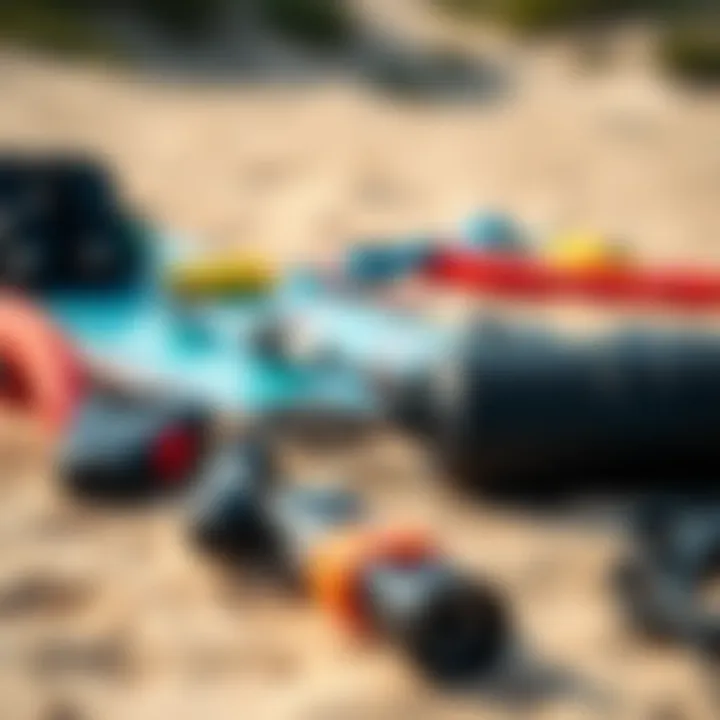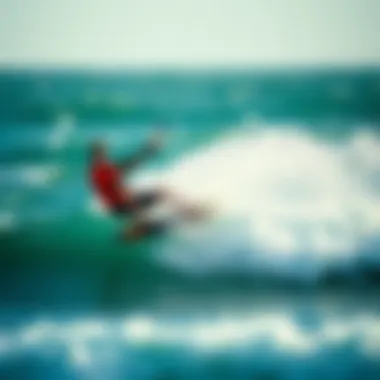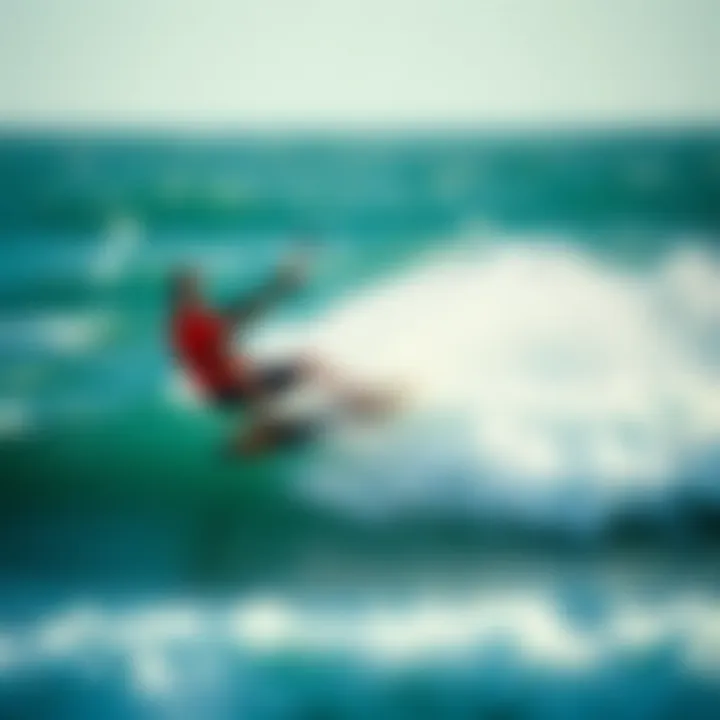The Ultimate Guide to Kiteboarding: Gear, Skills, and Culture


Intro
Kiteboarding, a sport that combines the thrill of surfing, sailing, and flying, has evolved into a dynamic activity for enthusiasts worldwide. Whether you're sliding through waves or gliding across flat waters, understanding the nuances of kiteboarding can significantly enhance your experience. This guide serves as a roadmap for both beginners looking to catch their first gust and seasoned riders wanting to refine their skills or connect with like-minded individuals.
As you delve into this guide, you'll discover insights into the essential gear that can make or break your ride, while also unpacking techniques that cater to all skill levels. Moreover, the guide doesn’t neglect the community aspect—after all, kiteboarding is as much about connection with fellow adventurers as it is about mastering the wind and water. Prepare to explore the interplay between equipment selection and riding techniques that will not only help you conquer the elements but also foster relationships with a vibrant and supportive community. From gear details to safety practices, this comprehensive overview is designed to empower you at every step of your kiteboarding journey.
Preamble to Kiteboarding
Kiteboarding, often seen as a perfect blend of surfing, sailing, and paragliding, has emerged as a vibrant watersport that appeals to a wide variety of enthusiasts. It's essential to grasp the nuances of this exhilarating activity right from the get-go, as it can lead to countless adventures and foster a deep sense of connection with both nature and the community around it. This sport isn’t just about the adrenaline rush; it’s a journey that shapes one’s character and respects the ocean.
One of the key benefits of starting kiteboarding is the exhilarating freedom it imparts. Harnessing the power of the wind through a kite creates a sensation akin to flying, which is hard to replicate in other activities. Beginner kiteboarders often revel in the challenge of mastering the wind and the sea, gaining not just skills, but confidence too. Besides the thrill, the sport brings physical health benefits, improving balance, coordination, and cardiovascular fitness.
However, while the excitement is palpable, potential participants must weigh considerations such as wind conditions, safety measures, and environmental impacts. Kiteboarding is dependent on specific weather conditions; understanding the wind patterns and water safety can mean the difference between a blissful ride and a dangerous experience. The responsibility that comes with this sport cannot be overlooked, as being aware of one’s surroundings is crucial.
In our exploration today, we’ll dive into the heart of kiteboarding, covering everything from the gear you’ll need to the technique you should learn. With the right knowledge, anyone can transition from a curious novice to a confident kiteboarder, while also engaging with the vibrant communities that encapsulate this sport.
"Kiteboarding isn't just a pastime; it's a lifestyle. The camaraderie, the challenges, and the sheer joy of gliding over water make it unique."
The importance of community in kiteboarding amplifies the experience. Taking part in group activities or learning from seasoned instructors adds a layer of safety and support to newbies and initiates.
Engaging with fellow kiteboarders provides not only camaraderie but also rich exchanges of personal stories and techniques that enhance one's journey. In the next parts, we will delve deeper into understanding the sport itself and the essential role of the kiteboarding community.
Essential Gear for Kiteboarding
Kiteboarding is a thrilling blend of skill, wind, and waves. However, without the proper gear, this high-spirited sport can quickly turn from exhilarating to overwhelming. The importance of having the right equipment cannot be overstated; it helps ensure safety, enhances performance, and allows for a more enjoyable experience on the water. Each piece of gear plays a crucial role, and understanding what you need can make all the difference to both beginners and seasoned riders alike.
Kites: Types and Functions
When it comes to kites, they are not all created equal. There are several types of kites, each designed for specific conditions and riding styles. Broadly speaking, kites can be categorized into two main types: foil kites and leading edge inflatables (LEIs).
- Foil Kites: These kites have a soft structure and rely on the wind to shape them. They excel in light winds and provide excellent speed and maneuverability. However, they are not the best choice for beginners, due to their complexity in setup and control.
- Leading Edge Inflatables (LEIs): These are the most popular choice among kiteboarders. With a rigid frame that holds its shape when inflated, LEIs are stable and user-friendly, making them ideal for new riders. They can thrive in various wind conditions but may require more maintenance.
Let's not forget about the sizes! Kites come in an array of sizes, typically ranging from 5 to 20 square meters. Ideally, your choice in size should align with your weight, skill level, and the wind conditions you expect to encounter. Essentially, a larger kite generates more power, while a smaller kite offers better control.
Boards: Choosing the Right Fit
Selecting the right board is akin to picking your perfect dance partner — it requires a good match for both the skill level and style of the rider. Boards come in different shapes and sizes, which affect how they perform on the water.
- Twin-tip Boards: Perhaps the most common choice, a twin-tip board is symmetrical, allowing for riding in both directions. This is perfect for beginners still finding their feet. Their stability makes it easy to learn tricks and maneuvers.
- Directional Boards: These are often favored by those who focus on wave riding. They provide better directional control and speed but can be more challenging for newbies.
When choosing a board, consider various factors like width, rocker (the curve of the board), and materials. A wider board provides more stability and is easier to ride in choppy water, while a board with more rocker allows for smoother turns and is better for tricks.
Harnesses and Control Bars
A good harness is as essential as your kite. It’s the connection between you and the kite, allowing for better power control while reducing fatigue. Harnesses come in two styles: waist harnesses and seat harnesses.
- Waist Harnesses: These fit snugly around your waist and offer freedom of movement, ideal for tricks and jumps. However, they may not provide as much support as a seat harness.
- Seat Harnesses: These wrap around the hips and lower body, offering superior support, especially for those who experience lower back strain. They are often recommended for new riders since they help distribute the load more effectively.
The control bar is also critical. This is attached to the kite and is how you steer and control its power. Make sure the bar width matches your kite size. A narrower bar allows for quicker movements, while a wider bar offers more control.
Safety Equipment: Importance and Options
In kiteboarding, safety gear might not be the most glamorous, but it’s indispensable. Planning for the unexpected is essential. Here’s what to consider:
- Helmet: Wearing a helmet protects against head injuries. It’s a must-have when you’re learning or trying new tricks. Adjustable designs provide comfort and fit that suits your needs.
- Impact Vest: This serves two purposes: providing flotation and helping to absorb the impact from accidental falls into the water. Choose a vest that fits snugly without limiting movement.
- Leashes: A safety leash connects you to your kite, preventing it from drifting away in case of a crash. Check local rules about leash types, as some locations have requirements for use.
Investing in these safety measures is smart. After all, it’s better to be safe than sorry when you’re out making waves.
"The winds of fortune can change at any moment—gear up accordingly."


As you dive into the kiteboarding experience, don't neglect your safety gear.
In summary, choosing the right equipment is pivotal to enhancing your kiteboarding experience. By understanding the different types of kites, boards, harnesses, control bars, and safety equipment, you empower yourself to make informed decisions. This knowledge not only hones your skill but also enriches your enjoyment of this dynamic sport.
Learning Kiteboarding: Techniques and Tips
Learning the art of kiteboarding is akin to unlocking a thrilling adventure. Not only does it provide an opportunity to tap into the elements with the sheer force of the wind beneath your feet, but it also opens doors to a vibrant community filled with enthusiasts. The techniques and tips you master along the way can significantly affect your experience, enhancing both safety and enjoyment on the water.
Kiteboarding is not simply about zipping across waves; it requires a good grasp of core skills to progress through phases, from a cautious beginner to an exhilarating advanced rider. In this section, tackling distinct levels is crucial. Each stage contributes to a deeper understanding of how you can navigate the sport effectively, enhancing your skills while keeping safety at the forefront.
Getting Started: First Steps
Stepping into kiteboarding can be overwhelming for those new to the sport. It’s paramount to start with the basics, ensuring that you have a solid foundation to build upon.
- Choosing the Right School: A reputable kiteboarding school will be your best ally. Look for instructors with ample experience and certification. They possess invaluable knowledge about both techniques and local conditions.
- Safety First: Understand safety measures such as the Quick Release mechanism and the importance of the safety leash. Knowing how to react in emergency situations can mean the difference between a thrilling ride and a potential mishap.
- Equipment Familiarization: Before hitting the water, spend some time familiarizing yourself with the kite’s components and functions. This includes the kite itself, harness, control bar, and lines. The better you know your gear, the more confident you will feel.
- Practicing on Solid Ground: Begin by practicing your flying skills on land. Getting comfortable with the power and control of the kite while standing on stable ground is essential.
Remember, everyone has to start somewhere. Don’t rush the process; take the time to enjoy every moment as you embark on this journey.
Intermediate Techniques: Building Skills
Once you’ve navigated the first steps, it’s time to evolve, mastering essential skills and familiarizing yourself with various techniques.
- Riding Upwind: This skill is crucial for independence on the water. Practicing your edge control and body positioning will help you maintain your course against the wind without losing too much ground.
- Transitioning: The ability to switch between riding directions smoothly is key. Start with simple transitions, focusing on balance and control. Gradually, you can add flair to your technique as your confidence grows.
- Jumping: Taking to the skies adds an exhilarating aspect to kiteboarding. Start with small hops by adding tension to the lines and using your legs to propel yourself. Remember not to push too hard initially. Gradual progression is the name of the game.
Each time you step onto the board, view it as a blank canvas. As you practice these techniques, you’ll find your style and rhythm, making the sport feel uniquely yours.
Advanced Maneuvers: Tricks and Stunts
For those who have honed their skills, advanced tricks and stunts represent the next chapter in kiteboarding. While practice is vital, a clear understanding of technique is equally important to ensure both enjoyment and safety.
- Flat Water Tricks: Perfecting tricks like the back roll or front roll requires a solid foundation of confidence and control. Start small and gradually build complexity.
- Wave Riding: This involves using the natural contours of the waves to perform maneuvers. Timing, control, and understanding wave dynamics are essential to excel in this domain.
- Kiteloops: A more advanced trick that involves looping your kite in the air as you jump, creating an exhilarating experience. Ensure you’ve mastered jumps and transitions before attempting this maneuver, as it requires precision.
"Kiteboarding is a dance with the wind. Each movement should be fluid and intentional. Only then does the beauty of the sport reveal itself."
Just like any craft, kiteboarding takes time and commitment to master. Focus on creating progress, however small. Whether you're learning to ride upwind or nailing that perfect maneuver, your dedication will see you soaring to new heights in no time.
As you embark on your kiteboarding journey, take advantage of community resources, local forums, and experienced riders. Engaging with the kiteboarding community can help you develop your skills further, offering insights that might prove invaluable. For more insights, check out Reddit Kiteboarding and local schools listed on Kiteboarding School Directory for more practical tips.
Safety in Kiteboarding
Kiteboarding is an exhilarating sport that draws enthusiasts from all corners of the globe, but like any adventure involving wind and water, it carries its fair share of risks. Safeguarding oneself while enjoying this thrilling activity is essential. This section will delve into pivotal aspects of kiteboarding safety, such as understanding wind conditions, emergency protocols, and effective communication with other riders. The goal is to ensure that each participant not only enjoys the ride but does so safely, creating a more positive atmosphere for all involved.
Understanding Wind Conditions
The wind is, without a doubt, the lifeblood of kiteboarding. When it comes to riding, understanding wind conditions can mean the difference between a great day on the water and a potentially dangerous situation. Riders should familiarize themselves with local wind patterns, as these can vary dramatically from one spot to another.
Before taking flight, it’s prudent to check the wind speed and direction. Wind meters can help gauge these factors, but often, a simple observation can do the trick. Look at the water surface; if it’s choppy and white caps form, the wind is likely strong. Calm waters indicate lighter winds. Always be aware of signs such as clouds that could signal changes in wind behavior as well.
A common idiom among kiteboarders is, "Respect the wind, or it will teach you a lesson." This rings true as even skilled riders can become overconfident, pushing boundaries without respecting the unpredictable nature of wind. Understanding your own experience level in correlation with wind conditions is also vital. If conditions seem beyond your expertise, it’s better to sit back and wait for a more favorable day.
Emergency Protocols
Preparation for unexpected situations can take a routine kiteboarding session to a safer level. Riders should discuss and implement comprehensive emergency protocols before hitting the water. Each kiteboarder should understand the actions to take in the face of various emergencies, like a sudden wind shift or equipment failure.
- Rescue Signals: Establishing a clear signal system among riders can reduce confusion. For instance, a raised hand can signal distress, while waving an arm can indicate a need for assistance.
- Buddy System: Never underestimate the importance of riding with a partner. Having a buddy nearby not only makes for memorable moments but also ensures aid is close at hand if needed.
- Kitemare: If you find yourself tangled in your kite, remain calm. Depower the kite by pulling on the back lines, and attempt to move toward the shore. If the situation escalates, signal for help.
Knowing how to react can mitigate risks considerably. As one rider put it, "A prepared rider is a safe rider."
Communicating with Other Riders


The kiteboarding community thrives on interaction; communication among riders can enhance both safety and enjoyment. Knowing how to effectively communicate with others on the water helps in various situations, from sharing tips to warning about dangers.
- Hand Signals: Establishing hand signals can be a game changer. Simple gestures can indicate when you are taking off, landing, or need to switch directions. A thumbs-up can indicate one is ready to ride, while a crossing motion may convey to slow down or stop.
- Verbal Communication: When possible, verbal exchanges can be invaluable. A quick chat at the beach can clarify where everyone plans to ride, which can help you steer clear of potential collision areas.
- Online Forums and Communities: Engaging with local kiteboarding forums typically found on platforms like Reddit or specialized kiteboarding sites can help riders stay informed about local conditions, share safety tips, and forge connections with fellow enthusiasts.
Ultimately, kiteboarding is more than just a sport; it's a way to connect, and fostering open lines of communication ensures everyone is on the same page, promoting a safer riding environment.
"Communication is key in kiteboarding, both on the water and off." - Anonymous
Traveling for Kiteboarding
Traveling for kiteboarding is not just about the thrill of catching the wind and riding the waves; it's also an integral experience that enhances one's love for the sport. When heading to different locations, kiteboarders get a chance to explore various environments, cultures, and kiteboarding communities. This exploration can lead to vital skills improvement and unforgettable memories combined with essential social interactions. The importance of travel in kiteboarding can be looked at from various angles.
On one hand, it allows kiteboarders to engage with unique geographical features that can provide new excitement to the sport. On the other hand, it also prompts one to consider local regulations, safety conditions, and community interactions, all of which can greatly influence one's experience. When you travel, you're not merely chasing the best wind; you're also diving into a vibrant tapestry of shared experiences, friendships, and local customs that shape your kiteboarding journey.
Top Kiteboarding Destinations
Choosing the right destination can make all the difference, and there’s plenty of spots around the globe that are renowned for kiteboarding due to their wind conditions, scenic views, and top-notch facilities. Here are a few noteworthy destinations:
- Cape Town, South Africa: Known for its consistent winds and breathtaking scenery, this area is a hotspot for both newbies and pros. The beaches of Bloubergstrand offer both flat water and wave riding, catering to various styles.
- Punta Cana, Dominican Republic: This paradise is famous for its turquoise waters and steady wind. The lovely beaches provide not just fantastic conditions for kiteboarding but also a place to relax and recharge.
- Maui, Hawaii: This iconic island is a part of wave riding history. The winds here can be fierce, creating thrilling conditions that experienced kiteboarders cherish. The community here is both welcoming and enthusiastic.
These destinations stand out not just for the wind but also for the opportunity to meet fellow kiteboarders from around the world, adding a richer layer to the experience.
Local Conditions and Considerations
Before you pack your bags, it’s important to dig a little deeper into the local conditions and customs of your chosen destination. Here are aspects to consider:
- Wind Patterns: Each place has its own wind characteristics that vary throughout the seasons. Knowing the best time to visit a destination can save a kiteboarder a lot of heartache.
- Local Laws and Regulations: Some areas may have specific rules regarding kiteboarding practices. It’s essential to familiarize yourself with these regulations to ensure compliance and safety.
- Environmental Awareness: Understanding the local ecosystem can help preserve it. Respect local wildlife and fragile ecosystems by being mindful of where you launch and land your kite.
- Community Engagement: It's worthwhile to connect with the local community. You can gather helpful tips for the best spots or even join local events. This connection can enrich your overall experience.
Traveling for kiteboarding is about embracing a culture, history, and lifestyle. By considering the elements that surround your kiteboarding adventure, you can leave behind a respectful footprint while enjoying the ride of your life.
Community Engagement in Kiteboarding
Engaging with the kiteboarding community is a crucial aspect that adds immeasurable value to the sport. It's not just about riding the waves; it’s about sharing experiences, learning from others, and creating lifelong connections. The kiteboarding community is diverse, bringing together individuals from all walks of life who share a passion for wind and water. When kiteboarders come together, they foster a sense of camaraderie that enhances skill development and enriches personal experiences.
Events and Competitions
Events and competitions in the kiteboarding world serve as major hubs for social interaction and skill development. These gatherings are more than just contests; they are celebrations of the sport. Kiteboarding competitions such as the Red Bull King of the Air or the GKA Kite World Tour draw riders from around the globe to showcase their talent.
The excitement doesn't just lie in competition; it’s in the atmosphere filled with energy. Participants and spectators intermingle, sharing tips and stories which can inspire new techniques. Apart from competition, events often include clinics, workshops, and training sessions led by experienced professionals. For many new riders, these sessions can provide a pivotal learning experience and boost their confidence.
- Networking Opportunities: Events are platforms for networking. Riders can meet sponsors, brands, and like-minded enthusiasts who can catalyze their journey in the sport.
- Cultural Exchange: As kiteboarders travel to various locations for competitions, they experience local cultures while bringing diverse perspectives into the community, creating a rich tapestry of global kiteboarding culture.
In essence, events and competitions refuse to just be about winning. They’re a way for kiteboarders to celebrate their love for the sport and deepen their connections.
Sharing Stories and Experiences
The stories from fellow kiteboarders embellish the learning curve in numerous ways. Sharing experiences can be both enlightening and motivating. Online platforms such as forums on Reddit or dedicated Facebook groups become bustling hubs for enthusiasts to share their adventures, tips, and even mishaps.
Hearing about someone catching their first big wave or the challenges they overcame on the water can act like a beacon for others facing similar hurdles. This collective knowledge can be invaluable, offering new riders insights that textbooks or videos cannot provide. Key points of focus might include:
- Mistakes and Lessons Learned: Sharing mistakes can save others from making the same blunders, and hearing of others’ journeys can offer practical solutions to common problems.
- Inspirational Tales: Stories of overcoming fear or achieving personal milestones serve as motivational fuel. They remind everyone that growth comes from persistence, not perfection.
Ultimately, storytelling creates a bond that cradles the very essence of kiteboarding culture.
Fostering New Kiteboarders
The engagement in the kiteboarding community is also marked by the collective effort to nurture the growth of new participants. Experienced riders have a unique position; they can play a vital role in ushering newcomers into the sport. Mentor-mentee relationships spray a sense of warmth across the community.
Instructors are not just teachers; they become friends in the process. Many riders volunteer or offer guidance during free clinics or community events. The focus here is on creating an environment where everyone, regardless of skill level, feels welcome.


- Workshops and Training Sessions: Events that include open workshops allow new kiteboarders to learn the ropes from seasoned pros. The tips shared during these sessions can improve their skills significantly.
- Community Support: Having a support system is essential. Experienced riders often create safe spaces where beginners can ask questions without feeling intimidated. This encouragement can make the difference between a fleeting interest and a lifelong passion.
The responsibility to foster new kiteboarders creates a cycle of giving back, ensuring that the community thrives and continues to grow. It nurtures the foundation of kiteboarding’s vibrant culture, illuminating the path ahead for those who are eager to sail into vast horizons.
Environmental Considerations
When it comes to kiteboarding, the thrill of riding high on the wind and water often overshadows a critical aspect: the environment. As kiteboarders, we are not just travelers navigating the waves; we are also custodians of the beautiful ecosystems we enjoy. Recognizing our impact on the environment is crucial.
The connection between kiteboarding and the natural world emphasizes the need for sustainable practices that promote minimal disruption to local ecosystems. Engaging thoughtfully with our surroundings ensures that the sport continues to thrive for future generations. Whether it’s about keeping our beaches clean or choosing eco-friendly equipment, each action counts.
Sustainable Practices in Kiteboarding
Sustainable practices in kiteboarding revolve around understanding how our choices affect the environment. Here are some recommendations:
- Equipment Choices: Opt for brands that prioritize sustainability in their manufacturing processes. Look for kites made from recycled materials or produced in facilities that follow eco-friendly practices.
- Leave No Trace: Respect the natural areas where you ride. Always clean up after yourself and educate fellow riders to do the same. Any trash left behind can harm wildlife and diminish the beauty of shared spaces.
- Local Awareness: Engage with local communities and respect the regulations regarding wildlife habitats. For instance, some areas may have designated no-boarding zones to protect nesting birds.
Utilizing these practices not only preserves the beautiful locales we kiteboard in but also aligns our passion with the health of the environment.
Impact on Local Ecosystems
Kiteboarding, while exhilarating, can have unintended consequences on local ecosystems if not approached with care. Here’s how this sport can affect the surroundings:
- Disturbance to Wildlife: Kitesurfing in sensitive areas can disturb wildlife, especially during breeding seasons. Animals may abandon nests or stop feeding, impacting their populations.
- Habitat Damage: Frequent foot traffic on sandy beaches or dunes can lead to erosion, adversely affecting both flora and fauna. The delicate balance of these ecosystems relies on maintaining natural habitats.
- Pollution and Waste: Littering or improper disposal of used gear can lead to pollution, affecting marine life and the overall health of coastal areas.
"The ocean is a powerful force, but our respect can be equally powerful if we merge our passion with responsibility."
For more information on environmental practices in outdoor sports, visit National Parks Service or check guidelines from Surfrider Foundation.
The Future of Kiteboarding
As kiteboarding continues to surge in popularity, the horizon of this exhilarating sport is filled with exciting possibilities. With each passing year, technological advancements shape the way enthusiasts engage with the sport, making it accessible, safer, and more thrilling than ever. This section will delve into the elements that not only define the future of kiteboarding but also underscore its significance within the greater sports and recreational landscape. Understanding these shifts is vital for kiteboarders, instructors, travelers, and adventurers alike, helping them to stay ahead of trends and innovations in this dynamic activity.
Technological Innovations
The technological advancements in kiteboarding have transformed the sport in profound ways. From cutting-edge materials used in kite construction to innovative designs that improve performance, each development enhances the overall kiteboarding experience. Here are key areas where technology is making waves:
- Kite Construction: Modern kites are often made with lighter and more durable materials, providing better performance while reducing the risk of breakage. Manufacturers like Cabrinha and Naish are continuously pushing the envelope, leading to kites that can withstand harsh conditions while remaining agile.
- Boards and Bindings: Today’s kiteboards come equipped with advanced features such as flex patterns tailored to rider style and wind conditions. Companies like Slingshot and North Kiteboarding are at the forefront, working on board designs that engage riders in new tricks and styles.
- Safety Enhancements: Innovations in safety equipment, such as automatic release systems and improved harness designs, are paramount in ensuring the well-being of kiteboarders. These enhancements reduce the likelihood of accidents and increase participation through instilling a greater sense of security among riders.
- Digital Integration: With the rise of wearable technology, kiteboarders can now track their performance metrics like speed, altitude, and distance using gadgets from brands such as GoPro or Garmin. This data not only helps riders improve but also fosters a competitive spirit in communities.
"Technological innovation is not just about creating better products; it's about enhancing the overall kiteboarding experience through safety and performance."
As these innovations continue to evolve, the sport attracts a wider demographic, paving the way for a stronger kiteboarding community.
Evolving Communities and Cultures
The future of kiteboarding isn’t solely about technological progression. Communities surrounding the sport are evolving, fostering a rich culture that binds enthusiasts from all walks of life. This shift is reflected in various aspects:
- Inclusivity: Kiteboarding is gradually becoming more inclusive, drawing in youth, women, and individuals from diverse backgrounds. Organizations worldwide are conducting outreach programs aimed at introducing kiteboarding to underrepresented groups, helping the sport flourish in various regions.
- Social Media Influence: Platforms like Instagram and Facebook have transformed how kiteboarders interact, share experiences, and learn from one another. This digital connectivity also aids in organizing localized events or virtual competitions, enabling riders across the globe to connect and participate.
- Environmental Awareness: The kiteboarding community is increasingly mindful of its environmental impact. Initiatives aimed at preserving coastlines and marine ecosystems are becoming common, with groups calling for sustainable practices that protect the places kiteboarders cherish.
- Cultural Exchange: Traveling for kiteboarding is not just about the thrill; it entails connecting with other cultures. Places like Tarifa, Spain, or the Bahamas serve as melting pots where diverse kiteboarders come together, blending their unique styles, stories, and techniques, enriching the sport’s cultural fabric.
Through these evolutions, kiteboarding stands to not only grow in numbers but also in depth, fostering an environment of learning, respect, and shared passion.
Culmination: Embracing the Kiteboarding Journey
As we wrap things up, it’s crucial to reflect on the broader implications of kiteboarding. This sport isn’t just about the wind filling your kite or the exhilarating rush as you ride the waves. Kiteboarding represents a journey of personal growth, a canvas for self-expression, and a bridge connecting us to an enthusiastic community. Whether you’re just dipping your toes into the sport or you’re an experienced rider carving your path, understanding the full extent of this journey can deepen your appreciation and commitment.
Reflection on Personal Growth
Kiteboarding encourages growth on multiple levels. Initially, there’s the physical aspect—developing strength and coordination. But it extends beyond that. Many riders discover a newfound confidence, forged through overcoming challenges on the water. Each fall and rise mirrors life’s hurdles. When you finally master a trick, it's more than just a feat of athleticism; it's a testament to perseverance. It shapes a mindset where success is defined not just by the outcome but by the sheer determination to keep going.
Additionally, the beauty of kiteboarding lies in its ability to foster relationships. Forming connections with others who share this passion can lead to diverse experiences and friendships that enrich life. There’s a certain camaraderie found on the beach, where stories swap like secrets over crashing waves, and mutual encouragement arises amidst competition.
Encouragement for Lifelong Learning
Kiteboarding is fundamentally about discovery. No matter how proficient one may become, the learning never truly stops. The wind won’t always cooperate, and conditions can change on a dime. Adaptation is key, and embracing the learning process is vital. From exploring new techniques to understanding the latest gear innovations, staying curious enhances not only your skills but also your excitement for the sport.
Moreover, as kiteboarding evolves, so do the communities surrounding it. Engaging with experienced riders, attending workshops, or participating in online forums all contribute to personal growth. Platforms like reddit.com provide a wealth of knowledge, connecting enthusiasts with tips, experiences, and inspiration.
In summary, kiteboarding is more than just a thrilling sport; it’s a lifestyle replete with opportunities for growth and learning. Whether you find yourself relishing in the beauty of nature or forming lifelong friendships, every moment spent on the water becomes a note in your journey's melody. Embrace it, cherish it, and let it guide you on your kiteboarding adventure!















